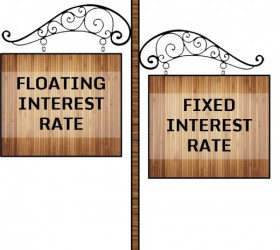Taking a Home Loan or opting for a Home Loan balance transfer is one of the easiest ways of buying a property, especially when you need help with the financing. All you need is a good CIBIL score and the ability to repay the loan amount. But, before you go ahead with the loan application, you need to know about the types of interest that can be levied on your Home Loan.
There are two kinds of interest that can be applied on your Home Loan—fixed and floating. Both of them have their own sets of pros and cons, which is why you should settle for the one that suits your requirements the best.
Here’s what you need to keep in mind when choosing between fixed and floating rates on your Home Loan or Home Loan balance transfer.
When should I go for a Fixed Rate of Interest?
The one main reason people opt for a fixed rate of interest is that the EMI amount remains the same throughout the tenure of the Home Loan. You don’t have to worry about market fluctuations and can peacefully repay your loan without any uncertainty regarding your EMIs.
As a general rule of thumb, if the EMI amount doesn’t exceed 35 to 40% of your income, you should go for a fixed rate of interest. Also, if you’re not likely to prepay your loan, then it’s better to settle for a low, fixed Home Loan rate of interest so that you can clear your debt at a comfortable pace.
However, remember that a fixed rate of interest might not remain fixed always, unless otherwise specified in your loan document. Some financial institutions renew the rates periodically, so be careful about what you’re signing up for.
When should I Opt for a Floating Rate of Interest?
A floating rate of interest usually starts lower than a fixed one, but it is directly affected by market conditions. If you have the financial stability to bear high EMIs, then you can opt for a floating rate of interest. Also, if you’re planning to close your loan account within 5 to 7 years, it makes more sense to pay EMIs at a floating rate of interest, because the interest outflow will be less over the tenure of your loan.
If you’ve conducted market research and you expect Home Loan rates to come down, then it’s best to go with a floating rate of interest. Also, recently, the RBI introduced a new lending rate, Marginal Cost of Funds-based Lending Rate or MCLR, which will be linked with all floating Home Loans.
The introduction of this system is to ensure that banks and NBFCs implement RBI directives like repo rate and CRR cuts as soon as they are announced. This way, the rate of interest on your Home Loan will come down when repo rates are slashed. This advantage can’t be availed by fixed rate Home Loan borrowers.
A fixed rate of interest is good for people who want to repay their loan over a long tenure and don’t want to take any risks. On the other hand, if you want to clear your debt within a short time and can bear high EMI charges once in awhile, you can opt for a floating rate of interest on your Home Loan.
